Gun Violence Seen Through the Eyes of Children
Twelve seconds of gunfire
In tiny Townville, S.C., first-graders are haunted by what they survived — and lost — on a school playground
By John Woodrow Cox, Originally published by The Washington Post on June 9, 2017
Ava Olsen, holding her cat, Autumn, in her room, alternated between bouts of solitude and anger after the shooting.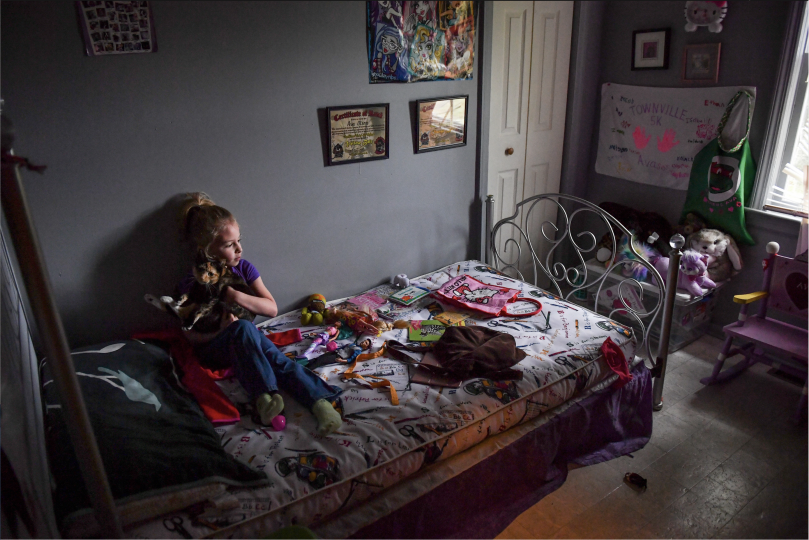
Recess had finally started, so Ava Olsen picked up her chocolate cupcake, then headed outside toward the swings. And that’s when the 7-year-old saw the gun.
It was black and in the hand of someone the first-graders on the playground would later describe as a thin, towering figure with wispy blond hair and angry eyes. Dressed in dark clothes and a baseball cap, he had just driven up in a Dodge Ram, jumping out of the pickup as it rolled into the chain-link fence that surrounded the play area. It was 1:41 on a balmy, blue-sky afternoon in late September, and Ava’s class was just emerging from an open door directly in front of him to join the other kids already outside. At first, a few of them assumed he had come to help with something or say hello.
Then he pulled the trigger.
“I hate my life,” the children heard him scream in the same moment he added Townville Elementary to the long list of American schools redefined by a shooting.
A round struck the shoulder of Ava’s teacher, who was standing at the green metal door, before she yanked it shut. But the shooter kept firing, shattering a glass window.
Near the cubbies inside, 6-year-old Collin Edwards felt his foot vibrate, then burn, as if he had stepped in a fire. A bullet had blown through the inside of his right ankle and popped out beneath his big toe, punching a hole in the sole of his Velcro-strapped sneaker. As his teachers pulled him away from the windows, Collin recalled later, he spotted a puddle of blood spreading across the gray wax tile floor in the hallway. Someone else, he realized, had been hurt, too.
Jacob Hall was the smallest child in first grade.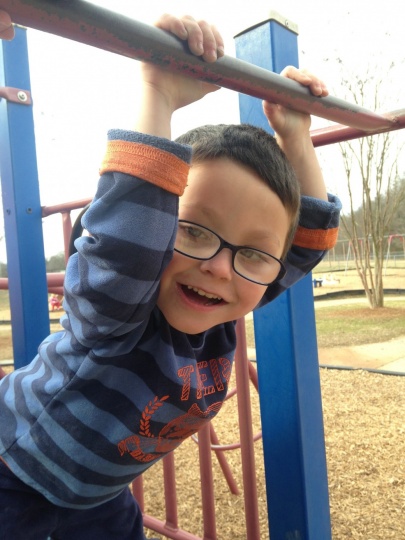
Standing on the wood chips near a yellow tube slide, Siena Kibilko felt stunned. Until that moment, her most serious concern had been which “How to Train Your Dragon” toy she would get for her upcoming seventh birthday.
“Run!” Siena recalled a teacher shouting, and she did.
Karson Robinson, one of the biggest kids in class, hadn’t waited for instructions. At the initial sound of gunshots, he scrambled over a fence on the opposite side of the playground and briefly headed toward the baseball fields where, as a Townville Giant, he had gotten his first recreation league hit. Karson then turned back to the school and found his classmates banging on a door.
“Let us in,” Siena begged, and the kids were hustled inside.
The gunfire had stopped by then, and, in a room on the other side of the school, Collin had discovered the source of all that blood.
Sprawled on the floor was Jacob, the boy Ava adored. At 3½ feet tall, he was the smallest child in first grade — everyone’s kid brother. On the green swings at recess, Collin would call him “Little J” because that always made Jacob cackle in a way that made everyone else laugh, too. But now his eyes were closed, and Collin wondered if they would ever open again.
“Press, press, press,” an automated defibrillator repeated as the school nurse pushed on Jacob’s chest, trying to keep him alive. “Give breath. Give breath.”
“Look at me,” a teacher urged Collin, but the boy couldn’t stop staring at his friend.
After the shooter was apprehended, a school bus transported shaken students to a nearby church.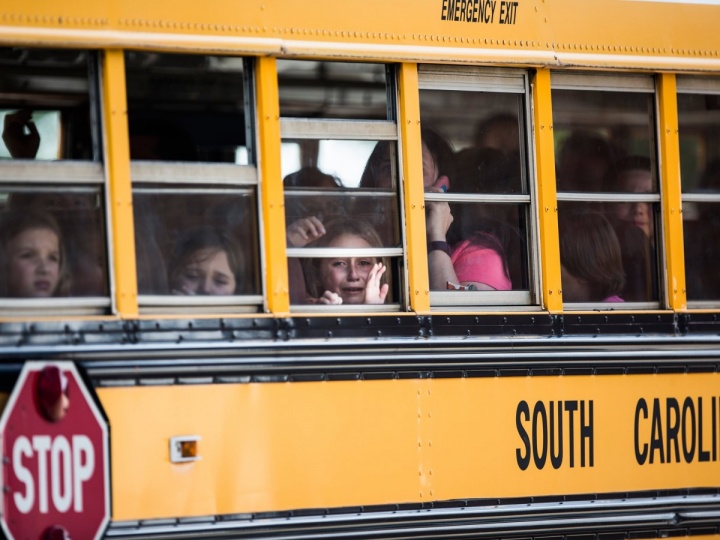
It was among hundreds of items — letters, ornaments, photos, posters, plush toys — that deluged the school of 290 students after the Sept. 28 attack. But the dreamcatcher held special meaning. It had been sent to four other schools ravaged by gun violence, and the names of each were listed on the back: Columbine High in Colorado, Red Lake High in Minnesota, Sandy Hook Elementary in Connecticut, Marysville Pilchuck High in Washington state.
A dreamcatcher sent to Townville Elementary has made stops at other schools where students have suffered trauma, including Columbine High and Sandy Hook Elementary.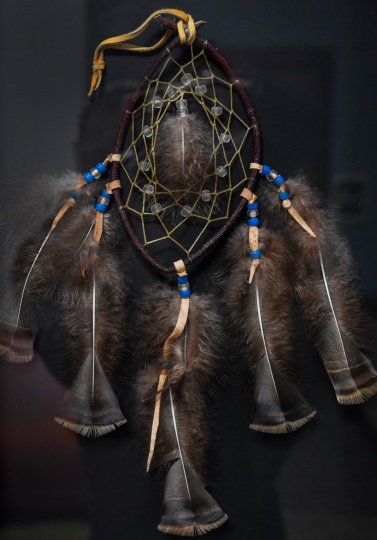
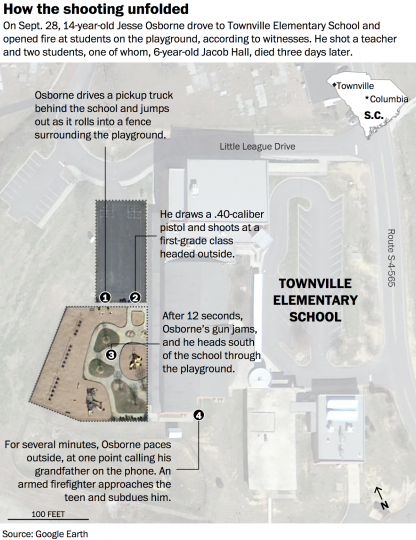
In each shooting’s wake, the children and adults who die and those who murder them become the focus of intense national attention. Often overlooked, though, are the students who survive the violence but are profoundly changed by it.
Beginning with Columbine 18 years ago, more than 135,000 students atten
ding at least 164 primary or secondary schools have experienced a shooting on campus, according to a Washington Post analysis of online archives, state enrollment figures and news stories. That doesn’t count dozens of suicides, accidents and after-school assaults that have also exposed children to gunfire.
“A meaningful number of those kids are going to have significant struggles,” said Bruce D. Perry, a psychiatrist who worked with families from Columbine and Sandy Hook. “It’s stunning how one event can have this echo that will impact so many more individuals than people realized.”
Every child reacts differently to violence at school, therapists have found. Some students, either immediately or later, suffer post-traumatic stress similar to combat veterans returning from war. Many grapple with recurring nightmares, are crippled by everyday noises, struggle to focus in classes and fear that the shooter will come after them again.
Because of the lasting damage, Townville’s teachers, administrators, first responders, counselors, pastors, parents and their children agreed to speak to The Post about what the community of 4,000 has endured over the past eight months.
They’d always felt safe in this swath of countryside, a place 40 miles southwest of Greenville that claims a single stoplight but at least six churches. Gable-roofed chicken houses stand among cow pastures and rolling fields of hay, wheat, corn and soybeans, and everyone shops at Dollar General, nicknamed the “Townville Target.”
Overwhelmingly white, it is home to families that have farmed for decades, retirees with lake houses, college-educated professionals who commute up the road to Clemson University and hundreds of people in mobile homes living from one paycheck to the next.
What connects them is a beloved two-story, red-brick school where generations of children have gathered to learn and play and grow up together.
Staff at Townville Elementary peered down at the teenage gunman through a second-floor window.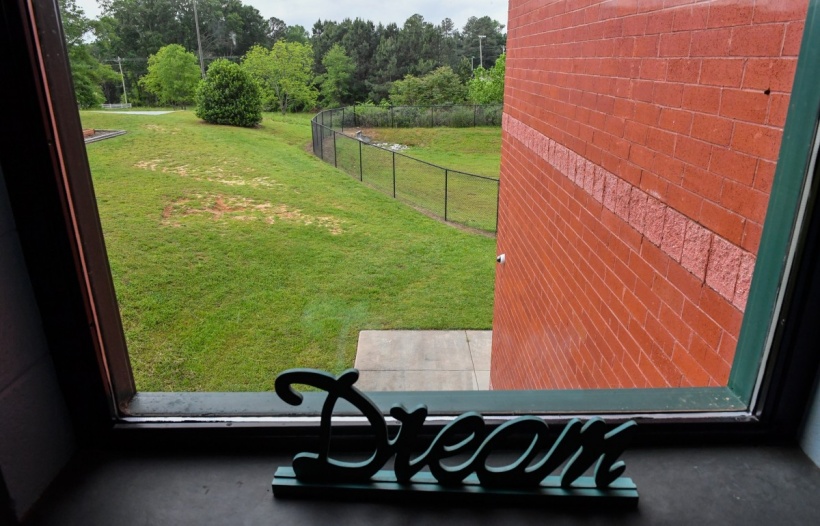
Moments earlier, as he had shifted his aim from the green metal door to the playground, his .40-caliber pistol jammed, ending his rampage 12 seconds after it began. Now Townville Principal Denise Fredericks and some of her staff congregated at the end of a second-floor hallway to keep track of him until help arrived. From behind a sign on a windowsill that read “Dream,” they peered down as he walked beside the school.
Then he looked up.
“That’s Jesse Osborne,” a teacher gasped.
He was 14 years old.
Jesse had attended Townville — walked its halls and romped on its playground — through fifth grade, before he transferred and was later home-schooled. Not once, Fredericks said, had his behavior prompted concern. He was quiet, earned good grades and almost never got into trouble. He played catcher in the recreation league. He got invited to birthday parties.
Jesse had called his grandmother, Patsy Osborne, just minutes before he’d driven to the school that afternoon. He was screaming, she said. She couldn’t understand him.
Patsy and her husband, Thomas, sped to his house, where they discovered their son — Jesse’s father — slumped on a couch, eyes still open. He’d been shot to death. And Jesse had disappeared.
Jesse Osborne shot a teacher and two students near the green metal door at left. Later, students sought shelter in cramped bathrooms.
It was his grandson.
“I told him not to,” he recalled the teenager saying. “I told him not to do that.”
His grandfather asked where he’d gone.
“I’m behind the school,” Jesse said.
Thomas pulled up moments after Jesse had been subdued by an armed volunteer firefighter, arriving in time to see his handcuffed grandson loaded into the back of a patrol car.
Inside the school, 300 children and teachers cowered in locked classrooms, bathrooms and storage closets. Siena remembered someone covering up windows with paper. Karson remembered playing with markers and magnets. Ava remembered a teacher reading a story about sunflowers. They all remembered the sound of weeping.
By then, Townville’s fire chief, Billy McAdams, had hurried through the first-grade door with the shot-out glass. In the classroom, he saw an alphabet rug soaked with blood.
Down the hallway, he found Jacob, whose femoral artery had been sliced by a bullet that struck his left leg. Eventually, the 6-year-old was loaded onto a gurney and taken to an awaiting helicopter, and Collin would never see his friend’s eyes open again.
Ava, 7, prays with her family — brother Cameron, 6; her father, David; and her mother, Mary — before dinner.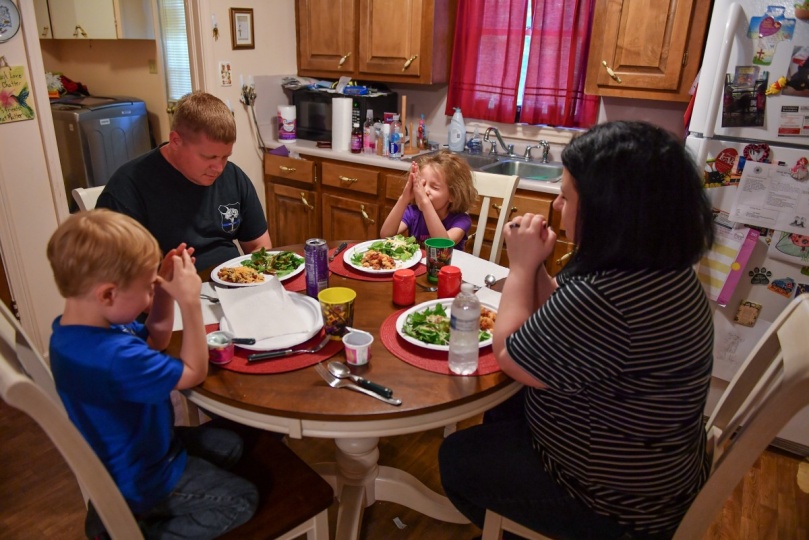
Ava couldn’t bear to look at him, so she sat on her mother’s lap near the back of Oakdale Baptist Church and turned away.
She called him “Jakey.” He was the only boy she’d ever kissed.
Nineteen days before he was shot, she had written him a note.
“Come play with me please,” she scribbled in pencil. “You can play with my cats. Do you want to get married when you come? My mom will make us lunch.”
At the bottom of the page, she’d drawn herself in a pink dress standing next to a bespectacled Jacob, who appeared about half her height. “I love you!” she added beside a red heart.
After the shooting, Ava realized she’d forgotten to give Jacob the letter and crumpled it into a plastic bin in her bedroom. Now she was at his funeral.
“He’s not really dead, is he?” she whispered to her mother.
“Yes,” Mary Olsen told her. “He is.”
Jacob’s family had asked that people attending the service dress like superheroes because of the boy’s infatuation with them. Ava wore a Ninja Turtles top with a purple cape. Siena and Collin, who was still in a wheelchair, both dressed as Captain America.
Jacob, 6, loved superheroes, and mourners were asked to dress up for the funeral. His mother, Renae Hall, who dressed as Robin, watches her son, who wore a Batman costume, placed into the hearse.
“Mama, that looks like that boy’s truck. Is he here?” Karson had asked, motioning toward a dark pickup.
From their seats, the children listened to the same pastor who presided at the funeral for Jesse’s father three days earlier. They watched as, midway through the service, Jacob’s mom staggered to his casket, then collapsed to the floor. They stared as his body was wheeled up the center aisle at the end of the memorial.
Then, just hours after their friend’s funeral, they returned for the first time to the place he’d been shot.
The school, scheduled to resume classes the next day, hosted an open house that afternoon. No one knew how the kids would react, but Fredericks, the principal, believed the small step of a brief return might help with the big step of a permanent one. In Townville, where nearly 7 in 10 of the school’s students live in poverty, it wasn’t viable to construct a new building or bus them elsewhere.
They had to go back.
When they did that afternoon, some kids even returned to the playground. Collin rolled out on his light blue medical scooter. Siena climbed a play set.
But Ava lingered behind with her mom.
“Please don’t make me go out there again,” Ava said, before they eased onto the sidewalk, holding hands. With each step, the girl’s fingernails dug deeper into her mother’s skin.
Siena, 7, began carrying stuffed animals after the shooting as a form of protection. Loud noises frighten her.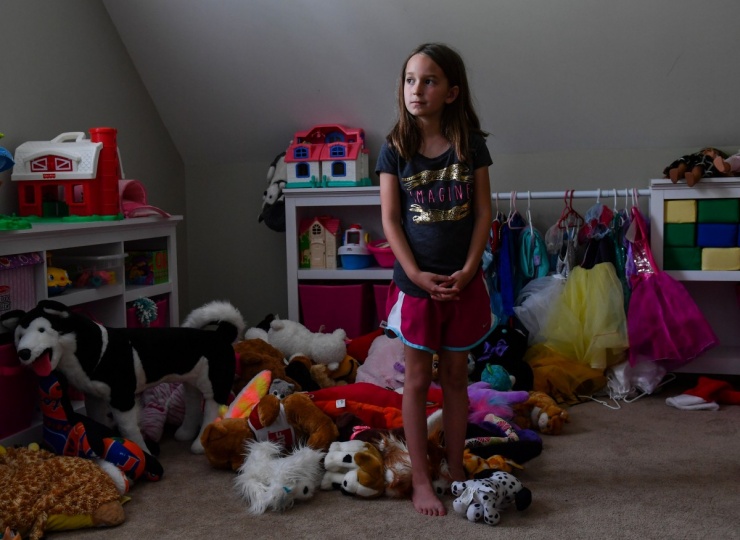
They explained that Jesse was in jail, that she was safe. But still, Siena obsessed over him coming for her again. Next to a sign beside her top bunk that read “Night, Night, Sweet Pea — Sweet Dreams,” she relived the shooting in her nightmares.
Fredericks and her staff did all they could think of to ease the kids’ dread on that first full day back, Oct. 6, when all but 10 students showed up for class. They were welcomed by uniformed officers, therapy dogs, volunteers in superhero costumes, more than 20 counselors, a line of signs — “Have a Great Day at School!” — in the parking lot.
For Siena, though, each morning included a negotiation with her parents.
“I don’t want to go to school today,” she would say. “I don’t feel good.”
At drop-off, she would search the parking lot for the cruiser of the police officer assigned to Townville Elementary after the shooting. She needed to know he was there.
One day, Siena announced to her mother, Marylea, that she couldn’t go to summer camp anymore: “They don’t have a police officer.”
Like many of her classmates, loud, unexpected sounds petrified her. Once, outside a Publix, a car backfired, and she dropped to the ground before dashing inside. Another time, after a balloon popped at a school dance, the entire gymnasium went silent as the principal rushed to turn the lights on. Fredericks later banned balloons at the spring festival.
“Noises are different now,” she said.
Siena and her friends began carrying stuffed animals as a form of protection. In those first days back at school, she would slip a tiny pink teddy bear named Lovie into her pocket and squeeze it when she walked onto the playground.
Even at home, she’d lost her sense of security. Siena, whose mom is earning a master’s degree at Clemson and whose dad runs a business, lives on a peaceful cul-de-sac in a two-story house that overlooks a lake.
Siena would deadbolt the front door when no one was looking, and at the sight of unfamiliar cars, she’d scurry inside.
One afternoon, she stood in her bedroom as Marylea ran her fingers through the girl’s shoulder-length brown hair. Siena again thought of Jesse as her dark eyes fixed on a pink heart taped to the wall.
“Are they going to let him out?” she asked, her finger picking at the decoration.
“Nope,” her mother said.
“Ever?”
Marylea didn’t want to lie. She searched for the right response, still stroking her 7-year-old’s hair.
“Not any time when you’re still a kid.”
Karson, 7, wonders if he could have done more to protect his friend Jacob, who was half a foot shorter than he was.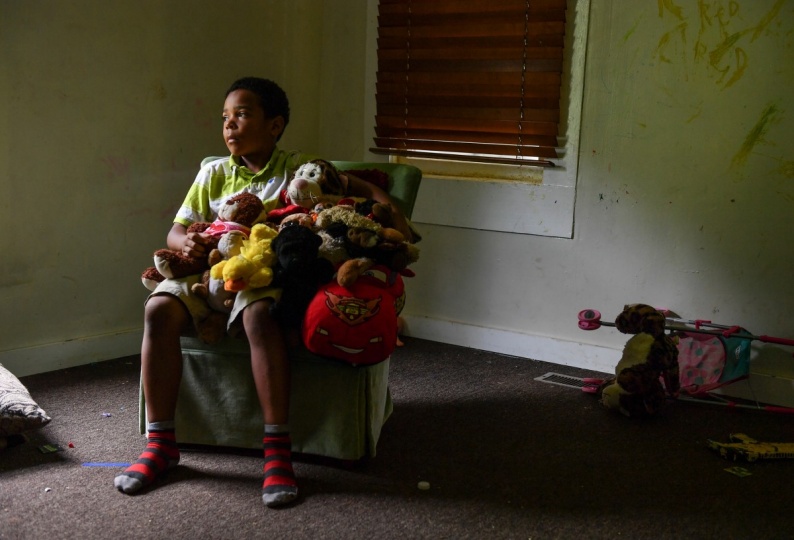
“Maybe I should have waited on Jacob,” he told his mother, Kayla Edmonds. “He could have jumped over the fence with me.”
She insisted that he couldn’t have saved Jacob’s life, but Karson wouldn’t be persuaded. He’d stood half a foot taller than his friend. The big kids were supposed to help the little ones.
The trauma had left him with intense separation anxiety — he’d follow his mother, who works at Subway, when she stepped out for a smoke — and profound grief. He’d known Jacob since they were toddlers. They’d bounced together for hours on a trampoline. They’d giggled together playing “Grand Theft Auto,” the video game with the bad words in it.
When Jacob died three days after the shooting, Karson’s mom didn’t tell him right away. It was his seventh birthday, and they were celebrating at Chuck E. Cheese’s. On their way home, he asked, yet again, if Jacob was getting better. In that moment, she told him his friend had gone to heaven, and Karson began to cry.
After that, he didn’t like it when people mentioned Jacob’s name. For Valentine’s Day, Karson wrote a card in his memory: “I loved him but he diyd but he is stil a life in my hart.”
Collin, now 7, can matter-of-factly discuss what happened on the day of the attack. He says the shooter's gun looked like a plastic, orange-tipped toy pistol in his room.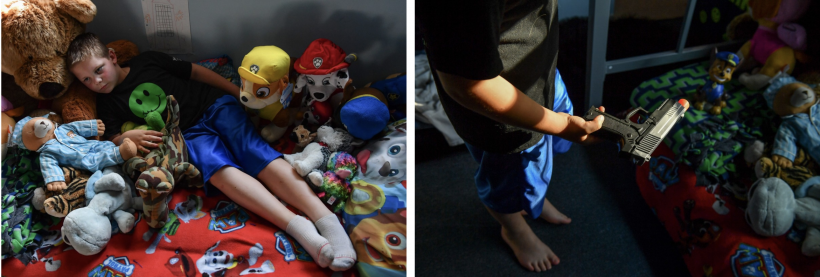
Now the boy picked past a T. rex figurine, a Burger King crown, a black Franklin baseball glove, the Captain America mask he wore to Jacob’s funeral.
Then Collin found what he was searching for and held up a plastic pistol with an orange cap on the barrel.
“His gun looked like that,” he said, his tone matter-of-fact as he explained how the Dollar General toy from China resembled the weapon that had nearly killed him.
Of all the children who survived that day, Collin seemed the most vulnerable to psychological damage in the eyes of many Townville parents and teachers. Before learning to tie his shoes, he’d been shot and seen his friend covered in blood. But he didn’t have nightmares, and he didn’t think much about Jesse. At school, as long as one of his stuffed animals was within reach, he felt fine.
His father, a 200-pound construction worker, broke down about what had happened more often than Collin did. It wasn’t that the boy didn’t care, because he did, especially for Jacob’s 4-year-old sister, Zoey, whom he’d often hug when he saw her at school.
But Collin, now 7, can discuss that day with clarity and composure.
About the bullet: “It was moving through the air super fast.”
About how much it hurt: “I didn’t even feel the exit hole. It was just the enter hole that had the most pain in it.”
About Jacob: “He wasn’t even moving.”
Researchers who have studied kids for years still aren’t certain why they react to trauma in such different ways.
Perhaps no one understands that better than Nelba Marquez-Greene, whose son survived the Sandy Hook massacre but whose daughter did not.
“That’s a factor you can’t predict — how your child is going to deal with it,” said Marquez-Greene, a family therapist for the past 13 years.
She warned, however, that parents can’t assume their kids have escaped the aftereffects, which sometimes don’t surface for years.
“We still have this tendency to want to say, ‘Okay, it’s done. He’s good. She’s good,’ ” Marquez-Greene said. “That’s not where the story ends.”
Ava gets a kiss as her dad arrives home from work. Months after the shooting, Ava still did not feel safe at school.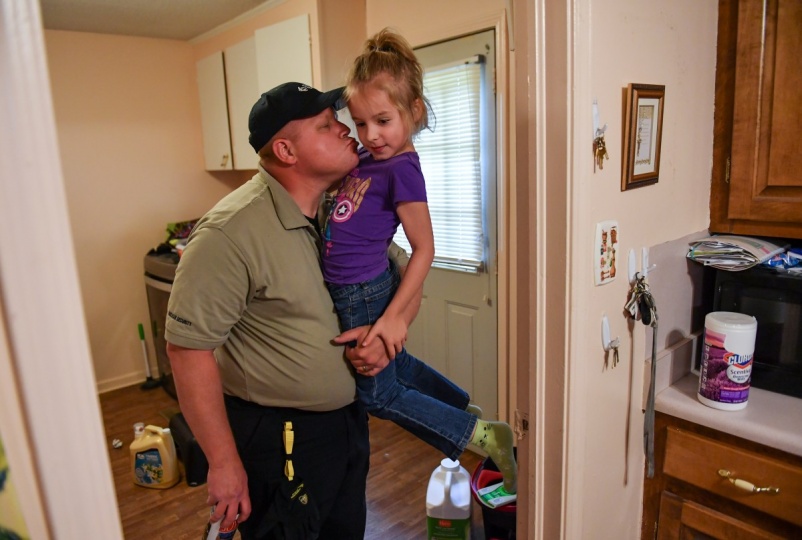
Did she still feel scared a lot?
“Yes,” Ava’s mother recalled her answering.
Did she feel safe at school?
“No.”
What did she not like about school?
Ava, clutching a stuffed Ninja Turtle that had once belonged to Jacob, didn’t answer.
Three weeks later, the doctor filled out a state form recommending that she be home-schooled. His diagnosis: “Severe PTSD/depression, exacerbated by school attendance.”
Ava — the only student pulled from Townville this school year because of the shooting — alternated between long stretches of quiet anguish and explosions of rage, her mother said. She started hitting herself and yanking out her eyelashes, and once clawed her nails so deep into her elbow that it became infected.
Ava had mastered a cartwheel days before the shooting but no longer talked about becoming a cheerleader. Instead, she began repeating what the shooter had screamed on the playground: “I hate my life.”
She stopped watching “Frozen” because Elsa’s parents die. She erupted when her mother took off the necklace with the vial of Jacob’s ashes his family had given them. She couldn’t look at the pistol her father, a former police officer, kept in the house. She snipped glittery green and red stickers into tiny pieces, then used them to cover up scary words in “Little House on the Prairie”: gun, fire, blood, kill.
Ava ducks to avoid seeing Townville Elementary as her brother, Cameron, is dropped off at school. She's now home-schooled, and she uses stickers to cover words in her books that she finds disturbing.
They didn’t know what to do, in part because their son, Cameron — just 10 months younger — had also been on the playground that day, but he fared far better in the aftermath. They sent Ava to two therapists, took her to doctors who gave her medication for anxiety, encouraged her to record her thoughts in a leopard-print journal.
“I miss Jacob,” she wrote one day in March.
“I can’t stop feeling mad,” she scribbled one day in April.
“No one ever listens to me,” she confided a few days later.
“I hate guns,” she scrawled a week after that.
Ava had made progress, her parents thought, until the day before Easter, when she and her brother were playing “boat” in the bed of their dad’s Chevrolet pickup outside the family’s home. Suddenly, Cameron frightened her. She pushed him and he fell backward, hitting his head against a stone well. Blood trickled down the back of his neck.
“Oh my God,” she screamed.
Their parents loaded the kids into the car and rushed to the emergency room.
“I don’t want to die,” Cameron cried. Then Ava, fearing what she’d done to him, said:
“I’m just like Jesse.”
Jesse Osborne, now 14, sometimes had heated arguments with his father, seen in an undated photo. His mother, Tiffney, in a photo taken weeks before the shooting, says the violent day came as a shock.
“I don’t want to go to hell,” he told Patsy, his grandmother.
Jesse, who hasn’t entered a plea but could serve decades in prison if he’s tried as an adult, spends most of his time reading, particularly about Mars, his family said. He wants to fly there one day.
They don’t dispute the accusations against him, but they’ve struggled to understand why their “baby,” who stands taller than 6 feet, would harm anyone.
His mother, Tiffney Osborne, remembers the wild rabbit he once rescued from the jaws of a family guard dog. Jesse kept it alive for five days in a cardboard box.
His grandmother remembers his reluctance to work with his father, Jeffrey, in their farm’s chicken houses because he didn’t like to break the birds’ necks.
His grandfather remembers camping trips to North Carolina and the day they saw “Frozen,” one of Jesse’s favorites.
Many of the 4,000 people who call Townville home say they've always felt safe in their one-stoplight community of farmers, retirees and college professionals.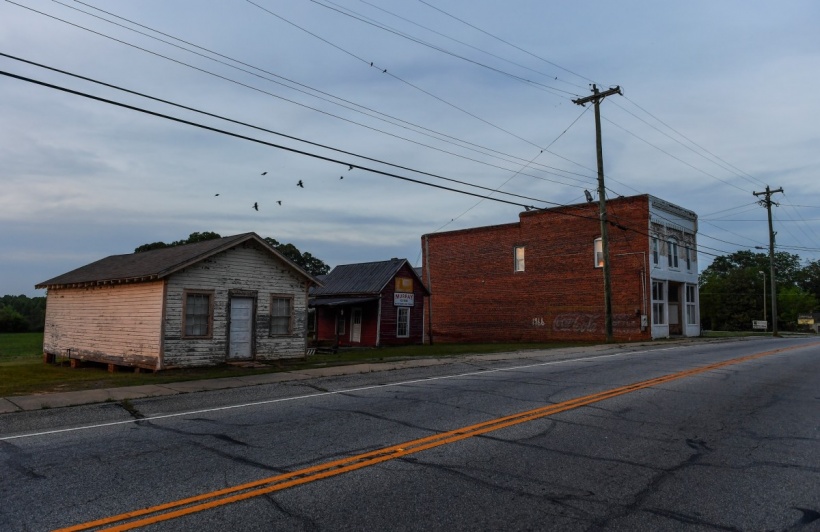
They’ve all heard the theory that he shot his father because he thought Jeffrey had killed a pet bunny, “Floppy.” Maybe, his grandfather said, that’s what Jesse meant in the call — “I told him not to do that.” But maybe he fired the gun for some other reason. Father and son, Tiffney said, sometimes had heated arguments.
Jesse, his mother said she’d learned, had retrieved the pistol from her husband’s nightstand and shot him from behind. After his arrest, he confided to her that he didn’t want his dad to suffer, so when Jesse realized Jeffrey was still moving after the first bullet, he kept firing.
The teen told the firefighter who restrained him that he’d lost faith in God and didn’t know what else to do, said McAdams, the fire chief. Jesse also told the firefighter that he was sorry.
His mother and grandparents insist they didn’t see that bloody day coming, but Jesse may have offered at least one sign he was capable of violence. In seventh grade, his family said, he was kicked out of school after bullies harassed him and he snapped. A fellow student, Patsy said, had spotted something frightening in his backpack: a hatchet.
The school playground, the scene of sudden violence last September, continues to be used by students today.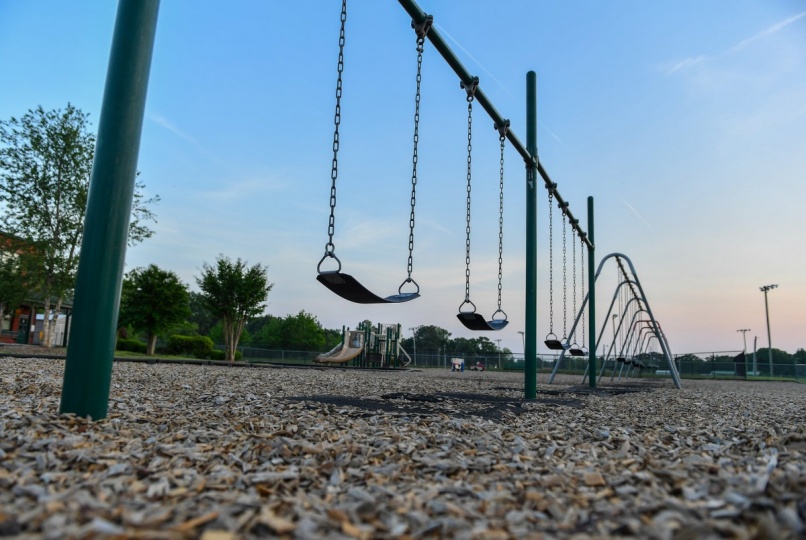
Some kids headed to the swings and others to the play sets. Collin, wearing a black T-shirt with a green smiley face, talked to a friend at a picnic table near where the truck had careened into the chain-link fence, since replaced by a shiny new section. He held his stuffed turtle, Tortle.
A game of tag broke out, and Karson chased a friend, just as he used to when he played the Joker and Jacob played Batman.
Collin darted by the green swings where he used to call out “Little J” to make Jacob laugh.
Siena, gripping a stuffed purple cheetah named Glamour, wandered past a pink metal ladder with a hole, likely the result of rust, that she believed had come from a bullet.
Four miles away, Ava’s mother said, the girl lay in bed next to Jacob’s old Ninja Turtle, her eyes still watery from another outburst.
As recess neared its end, a half-dozen of the kids carefully placed their stuffed animals atop a green metal bench.
Siena leaned down and pointed at Glamour.
“Stay there,” the girl said, racing to the monkey bars to see who could swing the farthest.
A pair of teachers — each holding red bags packed with first-aid kits — watched while their students ran, jumped, climbed and laughed.
When it was time to go back to class, the playground grew quieter as the first-graders returned to the bench. Then they picked up the stuffed animals and disappeared inside their school.
Jennifer Jenkins contributed to this report.



































































































